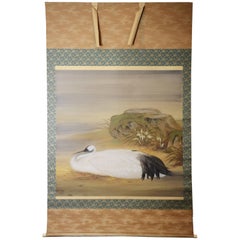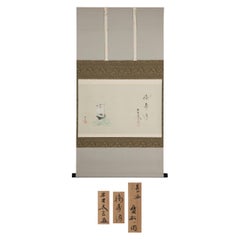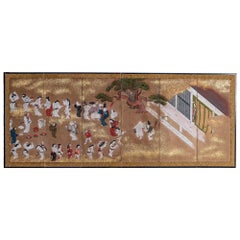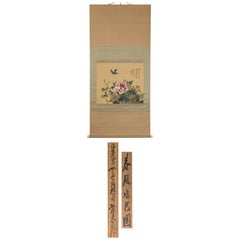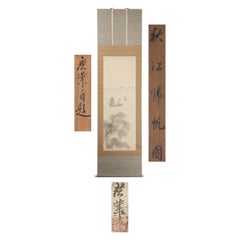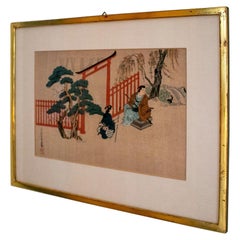Asian Paintings and Screens
to
285
925
319
1,487
103
9
41
26
16
4
4
2
2
162
604
721
112
285
149
68
36
4
30
13
6
16
19
19
7
2
710
674
617
520
425
1,599
1,428
921
451
135
1,599
1,558
1,572
29
4
3
3
2
Place of Origin: Asian
Large Antique Japanese Scroll Depicting a Nesting Crane, Taisho Period
Located in Prahran, Victoria
Large and exceptional Japanese hanging scroll with a realistically painted depiction of a nesting crane by Yoshifuji Yoshio, Taisho/Showa perio...
Category
Early 20th Century Taisho Asian Paintings and Screens
Materials
Paper, Silk
Lovely 20th Century Scroll Paintings Japan Tomobako Showa Artist Kobayashi
Located in Amsterdam, Noord Holland
Great decorated piece, artist Kobayashi Futoshi Gensho (B.1938-now)
Condition:
Very good. Size: Axis, vertical 117 cm horizontal 60.5 cm, painting, vertical 35 cm horizontal 58.5...
Category
20th Century Showa Asian Paintings and Screens
Materials
Fabric
$1,194 Sale Price
25% Off
Japanese Six Panel Screen: Tosa School Painting of Theatre Scene
Located in Hudson, NY
with thought to be Izumo no Okuni (1578-1613). Mineral pigments and gold dust on mulberry paper with silk brocade border.
Category
18th Century Antique Asian Paintings and Screens
Materials
Gold
Lovely Scroll Paintings Japan Artist Signed Wakasa Seigyo Monogai "Spring Breeze
Located in Amsterdam, Noord Holland
Wakasa Seigyo "spring breeze garden view", silk, colors, painting, hanging scroll, with box
Size: Axis, vertical 142 cm horizontal 65.5 cm
picture, vertical 44 cm horizontal 50.5...
Category
20th Century Showa Asian Paintings and Screens
Materials
Silk
$1,017 Sale Price
25% Off
Fabulous Landscape by Kōgyō Terasaki 1866-1919 Japan Painter Akita Prefecture
Located in Amsterdam, Noord Holland
Maruyama–Shijo style painting
Condition; Good but some stains.
Overall dimensions: width of about 28.2 cm and Length of about 173.8 cm
Painting width of about 25.5 cm × leng...
Category
19th Century Meiji Antique Asian Paintings and Screens
Materials
Bronze
$1,132 Sale Price
20% Off
1950s Japanese People Drawing w/ Giltwood Frame
Located in Marbella, ES
Original 1950s Japanese people drawing with giltwood frame
Frame measurements: 32x42x1cm.
Category
Late 20th Century Asian Paintings and Screens
Materials
Paper
"View from the Terrace, " Mixed-Media by Yamin Young
By Yamin Young
Located in Houston, TX
Well listed Chinese Artist Yamin Young. "View from the Terrace". Mixed-media on handmade rice paper, mounted to the fabric base, protected by the plexiglas...
Category
Late 20th Century Other Asian Paintings and Screens
Materials
Gold Leaf
Chinese Yangliuqing New Year Painting of Beauty and Baby, c. 1920
Located in Chicago, IL
Chinese New Year paintings (nian hua) are colorful folk paintings created to celebrate the annual Spring Festival. Drawn or printed by folk artists in regional studios, nian hua pain...
Category
1920s Folk Art Vintage Asian Paintings and Screens
Materials
Paper
Chinese Sign of Honor, circa 1850
Located in Chicago, IL
Signs of honor were presented as a gesture of gratitude to individuals who had bettered their community or in acknowledge of a respected person’s birthday. The sign would have been h...
Category
Mid-19th Century Qing Antique Asian Paintings and Screens
Materials
Elm
Miniature Mughal of Emperor Akbar And His Wife In His Courtyard, 19th Century
Located in Islamabad, PK
The Mughal miniature, meticulously created with a single-hair brush on delicate rice paper, depicts Emperor Shah Jahan in two distinct yet visually harmonious scenes with a courtesan...
Category
Mid-19th Century Anglo Raj Antique Asian Paintings and Screens
Materials
Gold Leaf
Chinese Chinoiserie Black Lacquered and Gold Coromandel 6 Panel Screen
Located in West Hartford, CT
Spectacular Chinese black lacquered 6 panel folding screen incised with gold gilt and white paint featuring Chinese village scenery. Feet...
Category
Mid-20th Century Chinese Export Asian Paintings and Screens
Materials
Wood, Lacquer
$3,360 Sale Price
20% Off
Taisho Period Calligraphy Screen: The Dragon's Song
Located in Fukuoka, JP
Taisho Period Calligraphy Screen: The Dragon's Song (2/2)
Period: Taisho
Size: 174 x 172.5 cm (68.5 x 67.9 inches)
SKU: PTA77
This calligraphy screen from the Taisho period is ...
Category
20th Century Taisho Asian Paintings and Screens
Materials
Silver Leaf
Japanese Silk Suijaku Scroll Nyorai-Kojin with Mixed Buddhism and Shinto Deities
Located in Atlanta, GA
A Japanese silk Suijaku hanging scroll beautifully presented in a custom wood shadow box frame from Edo period (circa 18-19th century). The scroll, surmounted on golden brocade was painted in fine details with gouache, ink and gold powder highlight, served as a Suijaku mandala for the worshippers. Honji Suijaku is a complicated religious concept uniquely developed in Japan. It mixed and hybrid the Buddism deities with native shinto spirits (known as Kami), which were seen as local manifestations (the suijaku, literally means a "trace") of Buddhist deities (the honji literally the original ground). The original idea may lie with the synergetic strategy to spread Buddism by making it more relatable to the local population who had already worshiped Shinto gods. The paradigm, adopted in the 10th century from an orignal Chinese concept, remained a defining feature of Japanese religious life up to the end of the Edo period (1868). Instead of being confined to deities, its application was often extended to historical figures as shown on this scroll.
This long hanging scroll depicts an arrangement of 21 figures including Buddhism and Shinto deities as well as two historical figures on the bottom. Each figure was name-tagged in Kanji for easy identification by the worshippers. It was used in the temple or shrine so that when the worshipper prayed in front the mandala, they prayed simultaneously to all the deities.
On the very top, sits Nyorai-Kojin, a hybrid deity of Nyorai Buddha and Kojin, the kaki for fire, stove and kitchen. From the top to bottom and left to right, here is the list of the deities: Kanon with Thousand Hands, Kanon with Willow Branch, Monju Bosatsu...
Category
Early 19th Century Edo Antique Asian Paintings and Screens
Materials
Silk, Wood
Japanese Two Panel Screen: Ink Calligraphy Poem of the Moon
Located in Hudson, NY
Poems refer to moon gazers. Ink on mulberry paper with a silk brocade border. Seals read: Roku-roku sai.
Category
19th Century Antique Asian Paintings and Screens
Materials
Brocade, Silk, Paper
Early 19th Century Japanese Scroll Bijin after the Bath in Summer
Located in Hudson, NY
Early 19th century Japanese Scroll: Bijin after the bath in summer. Painted in pigments on silk. Signature reads: Yamauchi Sentsu.
Japan,...
Category
Early 19th Century Edo Antique Asian Paintings and Screens
Materials
Silk, Wood
Chinese Yangliuqing New Year Painting of Peace & Prosperity, c. 1920
Located in Chicago, IL
Chinese New Year paintings (nian hua) are colorful folk paintings created to celebrate the annual Spring Festival. Drawn or printed by folk artists in regional studios, nian hua pain...
Category
1920s Folk Art Vintage Asian Paintings and Screens
Materials
Paper
Pair of Japanese Modern Bamboo Room Dividers Screens Decorative Panels Wall Art
Located in Rockaway, NJ
Pair of Japanese Modern Bamboo Room Dividers Screens Decorative Panels Wall Art
Category
20th Century Asian Paintings and Screens
Materials
Bamboo
Framed Korean Folk Shamanistic Painting of Seven Stars
Located in Atlanta, GA
A Korean folk painting watercolor on linen (silk) with a cloth mat and walnut wood frame. The work is in the shamanistic style and depicts the Tao...
Category
Early 20th Century Folk Art Asian Paintings and Screens
Materials
Textile
Chinese Yangliuqing New Year Painting of Beauty and Baby, c. 1920
Located in Chicago, IL
Chinese New Year paintings (nian hua) are colorful folk paintings created to celebrate the annual Spring Festival. Drawn or printed by folk artists in regional studios, nian hua pain...
Category
1920s Folk Art Vintage Asian Paintings and Screens
Materials
Paper
Vintage obi textile art " Camellia ~ Serendipity ~ " by ikasu Blue, Japan
By Kimono ikasu
Located in Setagaya City, JP
This work is inspired by traditional Japanese nature motifs symbolism, and is framed in paulownia wood originally used for a kimono chest-of-drawers.
In this artwork, the aim was to capture the the auspicious symbol of camellia used in antique kimono. Traditional Japanese culture, represented by the kimono, and wood, an integral element of Japanese craftsmanship, were used to bring this vision to life.
I used pieces of kimono that could no longer be used as clothing and kiritansu chest-of-drawers that would normally be discarded to create the ultimate upcycled piece.
<< Explanation and meaning of pattern and colors >>
This delicate piece features hand-drawn camellia motifs flowing gracefully on a softly brightened grayish background.
Camellias, native to Japan, bloom from winter to early spring. As an evergreen tree with green leaves throughout the year, it symbolizes the anticipation of spring and is considered an auspicious plant. Due to its seasonal significance and auspicious meanings, camellias have been used as motifs symbolizing good fortune. Additionally, they were highly valued for their use in oil, cosmetics, and medicine, representing nobility. Believed to possess the power to ward off misfortune, camellias also carry the meaning of "protection from calamity" and have strong ties to traditional ceremonies. In this artwork, camellias are delicately depicted alongside flowing branches, subtly representing good fortune with their pale pink and white hues.
"Sora-iro nezumi 空色鼠" refers to a light grayish color with a hint of blue, reminiscent of the slightly brightened sky on a lightly cloudy day. Popular during the late Edo period (19th cent.), it elegantly captures the slightly brighter sky pattern seen on lightly overcast days. Notably, the term "nezumi-iro" (mouse gray), popular during the late Edo period, was paired with brown tones, collectively known as "Forty-eight Teas and a Hundred Mice 四十八茶百鼠." Colors within the "nezumi" (gray) spectrum, particularly "sora-iro nezumi," were favored by young people for their cool and sophisticated appeal.
<< Characteristics of the fabric >>
The fabric features intricately woven patterns that reveal subtle gradations through dyeing, creating a grid pattern that transforms depending on the light conditions.
Originally, this fabric was part of a formal kimono known as a "hōmongi 訪問着," featuring motifs along the hem, shoulders, and sleeves. These motifs have been carefully selected and combined to create a unified piece of artwork.
<< About the frame >>
Kiritansu - chest-of-drawers for kimono, is traditionally made from paulownia wood, a uniquely Japanese material closely tied to the world of kimonos.
Paulownia wood is known as the lightest wood in Japan, prased for its natural luster, resistance to moisture, and resilience against cracking. Since ancient times, it has been used in crafting furniture, chests, and musical instruments.
During the Edo period, it became customary to store cherished kimonos in paulownia chests...
Category
1960s Japonisme Vintage Asian Paintings and Screens
Materials
Silk, Wood
Chinese Folk Drawing of Mythical Qilin, c. 1900
Located in Chicago, IL
Beautifully detailed and masterfully painted, this painting dating from the turn of the 20th century centers its expressive composition upon a rondel of Chinese symbols. Representing...
Category
Early 20th Century Qing Asian Paintings and Screens
Materials
Muslin, Elm
$1,176 Sale Price
30% Off
Chinese Ancestor Portrait
Located in Schellebelle, BE
Beautiful original Chinese Ancestor Portrait
with a Chinese married couple
great faded colors.
Category
18th Century Antique Asian Paintings and Screens
Materials
Canvas
Large Antique Zen Japanese Ink Scroll After Sesson Shukei
Located in Atlanta, GA
A Japanese Sumi ink painting with light color wash mounted with brocade borders as a hanging scroll (Kakejiku). The painting depicts the famously eccentric Buddhist monks Hanshan and Shide (known in Japan as Kanzan and Jittoku). Often as a pair, they have been a popular motif in Japanese Zen painting...
Category
18th Century Japonisme Antique Asian Paintings and Screens
Materials
Silk, Paper
Chinese Relief Carved Architectural Panel with Fruit and Flora, c. 1850
Located in Chicago, IL
It’s difficult to pinpoint what makes this handcrafted panel so impressive: the artful relief carvings of seasonal fruit and lush, foliage-filled vases ...
Category
Mid-19th Century Qing Antique Asian Paintings and Screens
Materials
Spruce
19th Century Chinese Qing Dynasty Reverse Painted Mirror
Located in Dublin 8, IE
19th Century Chinese Qing Dynasty Reverse Painted Mirror depicting a Court Scene. Featuring four ladies in traditional garments, including one fishing, along with a bridge to the cen...
Category
19th Century Qing Antique Asian Paintings and Screens
Materials
Glass, Mirror, Paint
Japanese Two Panel Obara Screen: Mid Century Abstract
Located in Hudson, NY
Paper art screen (Obara) by Yamauchi Issei with abstract colored patterns consistent with work from the 1950's-60's.
Category
Mid-20th Century Asian Paintings and Screens
Materials
Wood, Paper
'Love and Lotus Boys' Early 20th Century Chinese Folk Painting
Located in Chicago, IL
Drawn with a fine line and fresh, sketched quality, this folk hanging unites two scenes of lucky hoho lotus boys circumscribed in frames punctuated with fruits such as pomegranate, symbolic of prosperity and good fortune. On top, the two explore the natural wonders of the world...
Category
Early 20th Century Qing Asian Paintings and Screens
Materials
Wood, Linen
1950s Indian Mughal Paper Drawing of a Hunting Party on Antique Court Fee Stamp
Located in Marbella, ES
1950s Indian Mughal gouache colorful paper drawing of a hunting party on an antique court fee stamp official paper of the state of Jaipur.
Part of a l...
Category
Mid-20th Century Asian Paintings and Screens
Materials
Paper
Japanese Six Panel Screen: Black and Gold Lacquer Flower Festival Cart
Located in Hudson, NY
Abundant flower arrangement of peonies in a basket, with a four legged rest to the right and a twig fence to the left. Fine lacquer ceremonial cart with silk ties and areas of raised...
Category
Early 19th Century Antique Asian Paintings and Screens
Materials
Gold Leaf
Japanese Two-Panel Screen, Harbor Scene in a Modernist View
Located in Hudson, NY
Bountiful mountain overlooking a city, divided by an occupied river. The shapes and colors that make up this unique painting allow for an unconventional take on a modern harbor view....
Category
Early 20th Century Asian Paintings and Screens
Materials
Gold, Brass
Monumental Chinese Early to Mid 20th Century Hand Painted 4 Panel Folding Screen
Located in Milford, NH
A monumental Chinese hand painted polychrome canvas on wooden frame four panel folding screen featuring village scenes and figures on both sides, with rolling hills and trees. The sc...
Category
Mid-20th Century Asian Paintings and Screens
Materials
Canvas, Wood, Paint
Meiji-Taisho Period Buddhist Temple Cabinet Doors
Located in Fukuoka, JP
Meiji-Taisho Period Buddhist Temple Cabinet Doors
Period: Meiji-Taisho
Size: 158 x 56 cm (62.2 x 22 inches)
SKU: PTA127
Embrace serenity with these temple cabinet doors from the ea...
Category
Late 19th Century Meiji Antique Asian Paintings and Screens
Materials
Wood
"We" by Ren Hui
By Ren Hui
Located in Chicago, IL
This exquisite woodcut, “We,” was made by internationally renowned Chinese artisan Ren Hui. His artworks reflect the artist’s richness of experience: he’s been a soldier, factory wor...
Category
21st Century and Contemporary Asian Paintings and Screens
Materials
Wood, Paint
$1,980
Vintage obi textile art "Broken Vase ~kintsugi~" by ikasu Black / Gold, Japan
By Kimono ikasu
Located in Setagaya City, JP
This textile artwork uses a vintage obi dated around 1980ies, with a feather motif, and arranges it so that it looks like a vase.
Antique obi, just as it is a broken vase, is united back again with black obijime - a string used to tie up obi when it’s worn. Framed in kiritansu (antique chest) paulownia wood.
It is elegantly framed with paulownia wood originally used for kimono chest-of-drawers, and is filled with storytelling and sense of luxury.
I used pieces of kimono that could no longer be used as clothing and kiritansu chest-of-drawers that would normally be discarded to create the ultimate upcycled piece.
<< Explanation and meaning of pattern and colors>>
Feathers hold various meanings and symbolism in Japanese traditional culture, often reflecting themes of spirituality, symbolism, and folklore. Here are some of the meanings associated with feathers in Japanese tradition:
・Divine Protection: Feathers are often seen as symbols of divine protection and spiritual guidance. Feathers, especially those from birds, are considered to be imbued with the protective energy, offering spiritual guardianship and safeguarding against negative forces.
・Connection to the Spirit World: Feathers are sometimes associated with the spirit world and the realm of the divine. In folklore and mythology, feathers are depicted as messengers between the earthly realm and the celestial realms.
・Symbol of Beauty and Elegance: Feathers are admired for their natural beauty, grace, and elegance. In traditional Japanese arts such as Noh theater, Kabuki, and dance performances like Kagura, actors and performers often use feathered costumes or accessories to enhance their appearance and convey a sense of refinement and sophistication.
・Sign of Good Luck and Prosperity: In Japanese folklore, certain birds like cranes and pheasants are considered symbols of good fortune, longevity, and prosperity. Feathers from these birds are often depicted in art and craftwork as auspicious symbols believed to bring blessings and positive energy to the bearer.
<>
Kiritansu - chest-of-drawers for kimono, is traditionally made from paulownia wood, a uniquely Japanese material closely tied to the world of kimonos.
Paulownia wood is known as the lightest wood in Japan, prased for its natural luster, resistance to moisture, and resilience against cracking. Since ancient times, it has been used in crafting furniture, chests, and musical instruments.
During the Edo period, it became customary to store cherished kimonos in paulownia chests...
Category
1980s Japonisme Vintage Asian Paintings and Screens
Materials
Silk, Wood
Japanese Silk Scroll of Daruma Hanabusa Itcho Edo Period
Located in Atlanta, GA
A Japanese hanging scroll attributed to Edo period painter Hanabusa Itcho (1652-1724). The artwork features a silk roundel nicely mounted in golden brocade background. The painting depicts a robed Daruma seated in meditation with his eyes widely open. The rendition of the famous monk, one of the most beloved subjects in Japanese art, was extremely minimalistic. With just a few effective ink strokes and patches of watercolor, it managed to successfully highlight the essence and spirit of Daruma. The roundel was possibly a center fragment of a larger painting by the artist and was remounted historically. Signed with one of his artist's names. It comes with a wood scroll box with ink inscription of title and artist formal name.
For a painting with the same signature, see number 1881,1210,0.1719 in the collection of the British Musuem. Also a horizontal scroll...
Category
18th Century Edo Antique Asian Paintings and Screens
Materials
Silk, Paper
Japanese Two Panel Screen: Bird on a Rock on a Minimalist Ground
Located in Hudson, NY
Lovely unusual shading and merging of colors. Mica paint on paper. Good example of western influence on Japanese art. Signature reads: (Masaharu) Ryo. Seal is unreadable.
Category
Early 20th Century Asian Paintings and Screens
Materials
Paper
Framed Shakyamuni Buddha Thangka Painting
Located in Miami, FL
Offered is a vibrant and intricate Tibetan Buddhist "thangka" (also known as "tangka", "thanka", or "tanka"), which is what a painting that serves as a visual representation of spiri...
Category
1960s Tibetan Vintage Asian Paintings and Screens
Materials
Bronze, Gold Leaf
Japanese Two Panel Screen: Lacquer Penguins
Located in Hudson, NY
Beige ground lacquer with black and grey lacquer penguins with small pieces of shell making up white areas. Lacquer on wood. Writing reads: Lacquer Screen By Izumi Atsuhiko. It was ...
Category
Early 20th Century Asian Paintings and Screens
Materials
Shell, Wood, Lacquer
Japanese Two-Panel Screen Chinese Style Painting with Calligraphy
Located in Hudson, NY
Painting of a perforated garden stone with red bamboo growing behind. Chinese zekku poem reads, "Returning home to my grass hut on a spring evening," by the Tang-poet Qian Qi. Screen...
Category
Early 20th Century Taisho Asian Paintings and Screens
Materials
Silk, Paper, Wood
Antique Japanese Hanging Scroll Attributed to Iwasa Matabei
Located in Atlanta, GA
An antique ink and color on paper hanging scroll (kakejiku) with brocade border. It appears to be a fragment of a larger hand scroll depicting a procession of a lord with his entoura...
Category
Early 17th Century Japonisme Antique Asian Paintings and Screens
Materials
Silk, Paper
Vintage kimono textile art "Fern ~Connection to Nature~" by ikasu Black , Japan
By Kimono ikasu
Located in Setagaya City, JP
This work uses an antique tomesode (festive kind of kimono) with fern design to evoke feelings of tranquility, harmony, and appreciation for the beauty of the environment. Can be used both vertically and horizontally.
It is elegantly framed with paulownia wood originally used for kimono chest-of-drawers, and is filled with storytelling and sense of luxury.
I used pieces of kimono that could no longer be used as clothing and kiritansu chest-of-drawers that would normally be discarded to create the ultimate upcycled piece.
<< Explanation of colors and patterns >>
In Japanese traditional culture, ferns, particularly the Japanese painted fern (Athyrium niponicum), hold several meanings and symbolisms:
・Elegance and Beauty: Ferns are admired for their graceful, delicate appearance and intricate leaf patterns. In Japanese aesthetics, they are appreciated for their natural beauty and are often used in gardens, landscapes, and floral arrangements to add a sense of refinement and elegance.
・Resilience and Perseverance: Ferns are known for their ability to thrive in diverse environments, including shady forests, rocky cliffs, and damp soil. Their resilience in the face of challenging conditions is seen as a symbol of endurance and perseverance. In Japanese culture, ferns may represent the ability to overcome adversity and flourish despite obstacles.
・Connection to Nature and Tranquility: Ferns are native to forested areas and are often associated with the natural world. In Japanese traditional culture, they symbolize a deep connection to nature and the importance of maintaining harmony with the environment. The lush green foliage of ferns evokes feelings of tranquility and peacefulness, making them popular motifs in Zen gardens and traditional landscape paintings.
・Purity and Simplicity: Ferns are emblematic of simplicity and purity in Japanese aesthetics. Their unassuming beauty and understated elegance reflect the principles of wabi-sabi, an aesthetic worldview that values imperfection, impermanence, and simplicity. Ferns may be used in tea ceremonies, Ikebana (flower arranging), and other traditional arts to evoke a sense of tranquility and appreciation for life's fleeting moments.
Overall, ferns in Japanese traditional culture symbolize elegance, resilience, connection to nature, purity, and simplicity. Their presence in art, literature, and landscape design underscores their enduring significance as symbols of natural beauty and spiritual resonance.
<< Characteristics of the fabric >>
This vintage textile is hand-painted with a traditional Japanese technique called "yuzen".
<< About the frame >>
Kiritansu - chest-of-drawers for kimono, is traditionally made from paulownia wood, a uniquely Japanese material closely tied to the world of kimonos.
Paulownia wood is known as the lightest wood in Japan, prased for its natural luster, resistance to moisture, and resilience against cracking. Since ancient times, it has been used in crafting furniture, chests, and musical instruments.
During the Edo period, it became customary to store cherished kimonos in paulownia chests...
Category
1960s Japonisme Vintage Asian Paintings and Screens
Materials
Silk, Wood
Japanese Two Panel Screen: Kanzan and Jittoku
Located in Hudson, NY
Prominent figures in Japanese folklore. The Chinese poet-sage Kanzan is depicted with his scroll, and the Daoist sage Jittoku with his broom. Painting bears two seals of Nakanuma Sho...
Category
Late 19th Century Antique Asian Paintings and Screens
Materials
Gold
Japanese Two Panel Screen, Zen Calligraphy Character Cloud
Located in Hudson, NY
Meiji period (1868 - 1912) calligraphy painting. Abstract character reads: Kumo (cloud). Seal on the upper right reads Shogazen, seal on the upper left reads Hosai. Ink on mulberr...
Category
Early 20th Century Meiji Asian Paintings and Screens
Materials
Silk, Wood, Paper
A Rare Drawing / Watercolour of Maharao Ram Singh of Kota and His Sons
Located in London, GB
A Rare Drawing / Watercolour of Maharao Ram Singh of Kota and His Sons Hunting with numerous Rajasthani inscriptions
Paper, Watercolour, Pencil
India
Late 18th Century - Early 19th...
Category
Early 19th Century Antique Asian Paintings and Screens
Materials
Paper
Original Balinese Traditional School Painting Harvest Artisan Signed and Framed
Located in Greer, SC
Stunning hand painted original Balinese traditional painting, featuring a scene of harvesting created in great detail. Signed by the artisan on the lower right hand corner. Measures ...
Category
Mid-20th Century Tribal Asian Paintings and Screens
Materials
Glass, Wood, Paper
Pair of Burmese Early 20th Century Giltwood Framed Paintings
Located in Lambertville, NJ
A pair of vibrantly colored Burmese water color paintings of Deities. The early 20th century paintings in mid 20th century professionally framed giltwood frames.
Category
Early 20th Century Asian Paintings and Screens
Materials
Glass, Giltwood, Paper
Vintage obi textile art "Under the Sun ~Serendipity " by ikasu Red / Beige Japan
By Kimono ikasu
Located in Setagaya City, JP
This artwork creatively uses tree bark to evoke the imagery of woods and mountains during both the morning and nighttime on left and right. It is elegantly framed with paulownia wood, a tree closely connected to kimono culture, and is filled with storytelling and sense of luxury.
By incorporating both the front and back sides of the same obi fabric woven in different colors, the play of light and shadow on the mountains is depicted through the contrasting appearances of these surfaces.
The intention behind this piece is to convey the exquisite beauty of Japanese mountains and the lush forests that inhabit them. To achieve this, traditional elements of Japanese culture, such as obi textiles and craftsmanship involving wood, were used.
The outer side and inner linings of the same obi, no longer suitable for clothing, along with bark material that would normally be discarded, have been repurposed to create this exceptional upcycle artwork.
The fusion of Japanese natural materials – silk, paulownia wood, and pine bark for the central decoration – along with the so-called "Tozan" pattern, a unique Japanese natural design showing mountains from far-away point, captures the magnificent beauty of Japanese nature from various perspectives.
The central bark decoration stands out as a distinctive feature of this work. Pine, oak, and other tree barks are interwoven among the mountains woven into the obi, creating a tangible and authentic natural atmosphere.
<< Period / Story >>
The obi used in this piece was originally crafted during the late Showa period (1960-80ies).
<< Explanation and meaning of pattern and colors >>
This upcycle artwork uses an obi with a tozan pattern woven in two colors. The design is inspired by a distant mountain range, a motif that has been used in paintings and crafts since ancient times. However, in this particular design, the mountains are depicted not as distant peaks but as graceful semicircles giving it a mild atmosphere.
<< Characteristics of the fabric >>
This upcycled Fukuro-obi (two-side obi) showcases a festive color pattern of mountains intricately woven with gold threads against a beige front and red on the back.
The way this obi interacts with light allows it to shift in expression, much like a mountain revealing different facets over time. It can transform from deep shades of color to the appearance of gold shimmering against bright hues, depending on the lighting and viewing angle.
<< About the frame >>
Kiritansu - chest-of-drawers for kimono, is traditionally made from paulownia wood, a uniquely Japanese material closely tied to the world of kimonos.
Paulownia wood is known as the lightest wood in Japan, prased for its natural luster, resistance to moisture, and resilience against cracking. Since ancient times, it has been used in crafting furniture, chests, and musical instruments.
During the Edo period, it became customary to store cherished kimonos in paulownia chests...
Category
Late 20th Century Japonisme Asian Paintings and Screens
Materials
Silk, Wood
Japanese Two-Panel Screen, Rimpa Style Chrysanthemums on a Twig Fence
Located in Hudson, NY
Detailed painting of varieties of chrysanthemums behind a bound-twig garden fence rendered in silvered, raised gofun. Stylized low-hanging gold mist clouds. Rimpa-style painting in m...
Category
Late 19th Century Antique Asian Paintings and Screens
Materials
Gold
Japanese Four Panel Screen Tibetan Mountain Monastery
Located in Hudson, NY
Powerful depiction of sprawling monastery with massive mountains in the background. Ink on paper. Signature and seal read: Tetsuzan.
Category
Early 19th Century Antique Asian Paintings and Screens
Materials
Paper
Framed Painting on Silk, Harbor at Night By: Chiga Saku
Located in Hudson, NY
Pigments on silk. Signature and seal read: Chiga saku (Acid free mounting with UV plexiglass) Painting dimentions: 59" H x 34" W, overall dimentions: 63 1/4" H x 38 1/2" W.
Category
Early 20th Century Asian Paintings and Screens
Materials
Silk
Original Liberty London 19th Century Chinese Canton Brush Painting Watercolor
By Liberty & Co.
Located in West Sussex, Pulborough
We are delighted to offer for sale this very rare original 19th century watercolor brush painting depicting a scene of typical every day Chinese life retailed through Liberty London....
Category
19th Century Modern Antique Asian Paintings and Screens
Materials
Paint
$763 Sale Price
30% Off
Japanese Four Panel Screen: Japanese Tree Sparrows on Stacks of Bailed Rice
Located in Hudson, NY
Sparrows ravish freshly harvested rice, drying on stakes, beyond wild chrysanthemum. Mineral pigments on silk. Signed in the lower left corner, signature reads: Soetsu. With a simple...
Category
Early 20th Century Asian Paintings and Screens
Materials
Silk, Wood, Lacquer
Rare Japanese painting, Skeletons Studying, Shaku Kaiyin, Japan Meiji Period
Located in PARIS, FR
Skeletons Studying, Shaku Kaiyin, Japan Meiji Period
This ink-on-paper painting, mounted as a scroll with colored paper borders, is titled Skeletons Studying. It portrays a circle of...
Category
Late 19th Century Antique Asian Paintings and Screens
Materials
Paper
$1,792 Sale Price
20% Off
Large Chinese Heavily Carved Wood Relief Plaque Wall Mounted Sculpture
Located in West Hartford, CT
Stunning vintage heavily carved relief, ready to hang. Now, more than ever, home is where the heart is.
Category
Mid-20th Century Chinese Export Asian Paintings and Screens
Materials
Wood
Japanese Two Panel Screen Abstract Design
Located in Hudson, NY
Lacquer on wood. Signature reads: Toshimasa. Solid black lacquer on reverse. Signed original box.
Category
Mid-20th Century Asian Paintings and Screens
Materials
Lacquer
19th Century Japanese Scroll of Hollyhocks
Located in Hudson, NY
Seal on lower right reads: I'nen. Beautiful and delicate Rimpa painting using tarashikomi (painting-in) technique of wet on wet painting. Painted in a style reminiscent of the famous...
Category
19th Century Antique Asian Paintings and Screens
Materials
Silk, Wood, Paper
Japanese Two Panel Screen Harbor Scene in Abstract Form
Located in Hudson, NY
Abstracted painting of ships moored in the background. Painted by Nishide Kofuku and exhibited at the 1963 Nitten National Exhibition. Kofuku was born in 1926 in Shiga Prefecture. He...
Category
Mid-20th Century Showa Asian Paintings and Screens
Materials
Metal, Brass
Japanese Two Panel Screen: Mountain Landscape with Calligraphy
Located in Hudson, NY
Japanese Two Panel Screen: Mountain Landscape with Calligraphy. Late Edo (c. 1850) painting of a dramatic mountainside carved by a waterfall with a crane flying in the foreground an...
Category
Mid-19th Century Edo Antique Asian Paintings and Screens
Materials
Silk, Wood, Paper
Japanese Single Wood Panel: Lacquered Wild Grasses
Located in Hudson, NY
Beautiful fine detail of a variety of wild grasses. Lacquer on wood panel with carved surface and metal rim. Exhibited at National Nitten Exhibition 1969.
Category
20th Century Asian Paintings and Screens
Materials
Metal
Pair Antique 19th Century 1880 Chinese Gouaches on Rice Paper Geisha Girl & Lord
Located in West Sussex, Pulborough
We are delighted to offer for sale this lovely pair of antique circa 1880’s Chinese hand painted Gouache paintings depicting a Geisha girl and Lord
A very good looking and beautifully painted pairing, they were made for the export market during the British colonialism...
Category
1880s Chinese Export Antique Asian Paintings and Screens
Materials
Paper
Recently Viewed
View AllMore Ways To Browse
Japanese Red Lacquer Frame
Lattice Panel Wood
Hanging Japanese Screen
Japanese Lattice
Japanese 19th Century Meiji Period Silk Painting
Japanese Buddhist Screen
Japanese Carved Screen
Japanese Screens And Doors
Monkey Screen
Japanese Autumn Screen
Japanese Screens Six Fold
Japanese Wood Room Divider
Kyoto Silk Painting
Japanese Dragon Painting
Japanese Birds Painted On Silk
Heian Period
Japanese Crane Panel
Japanese Divider Screen
